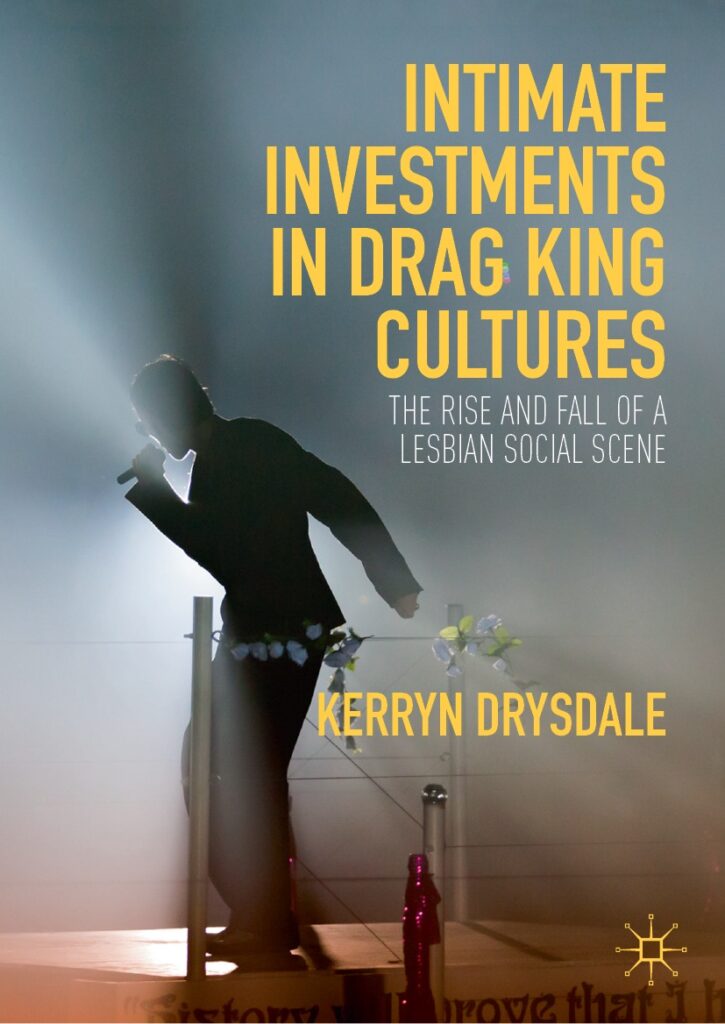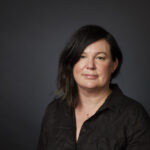Kerryn Drysdale
Intimate Investments in Drag King Cultures takes the globally recognised phenomenon of drag king performances as an opportunity for critical inquiry into the rise and fall of an urban scene for lesbian and queer women in Sydney, Australia (circa 1999-2012). But what happens when scenes fade, as they invariably do? Intimate Investments in Drag King Cultures is unique in capturing the perspective of a scene at the moment of its decline, revealing the process by which a contemporary movement becomes layered with historical significance. NOTCHES is grateful to Palgrave for permission to reproduce this extract.
The first time I saw a drag performance was on a Wednesday night, late in 2006 in the inner-city suburb of Newtown, Sydney. The sun was still high in the sky in the evening of that hot Australian summer, and the numerous beer gardens and open bars full of people escaping the humidity. I was with my new housemate Lisa who, despite recently arriving in Sydney from the UK, had lost no time in seeking out all the lesbian-oriented events in the area. It was at her suggestion that we went to “the Sly” that night. After the sun had set and with the remainder of the night still beckoning, we walked up from the main entertainment precinct on King Street towards the secondary thoroughfare, Enmore Road, following what I now know to have been an endless trail of women making the same journey. Our destination, The Sly Fox Hotel, was immediately obvious on approach, with masses of women milling around the entry.

The space inside the venue was dark and noisy, filled almost to capacity with women, as it was most Wednesday nights. I couldn’t see clearly into the back room because of all the people jammed in front of it, but there was something happening, back there on the stage that was only partially visible through the crush of people moving towards it. I remember being entranced by glimpses I got of the drag king as I craned to see over the heads of others, though I can’t recall the performer all these years later. Yet I keenly recall the palpable sense of excitement in the air amid the surging sounds of wolf whistling, laughter, and cheering that filled the space to the point where conversation was impossible. I don’t know what time it was when I left after all the drinking, dancing, and talking that went on that night, but it would have been very late when I stumbled home and crawled into bed. But I did know that I’d be back next week. And so it started: going to drag king shows, week after week, became a routine part of my social life. My five-year-long engagement with the drag king scene commenced that night, precipitating a slow immersion that eventually shaped my academic interest.
From their first emergence in the late-1990s, attending events featuring drag king performances proved a popular pastime for lesbian and queer-identified women in Sydney. But what cumulative effect does this pastime have, standing there in a crowded bar midweek surrounded by women watching a drag king on stage? And what does it mean to seek it out, again and again, so much so that I consistently stayed way past the time I had earlier—sternly—committed to myself as bedtime? Reflecting on this experience over a decade later, I found that while drag king performances were engaging, even titillating, they also signified a range of social dynamics established by the atmosphere generated in those packed spaces. And so I present my own fragmented memories of my first introduction to the scene here to gesture towards some of the connections that I’ll go on to explore between individual experience and social meaning. My experiences are obviously not the same everyone else’s who attended drag king events over their decade-long run in Sydney, but they connect in ways that give resonance to nights like the one I’ve just described. Together, such stories point to the possibility of collective intimacy in the charged promise of shared moments.
This is not a book about the history of drag kings, nor is it an account of the role they have played in the formation of lesbian communities. Rather, using drag kings as an entry point, this book is an exploration of a scene for lesbian and queer women in a particular social milieu. My own immersive engagement with this expansive performance culture indelibly shaped what follows in this book, certainly, but this account is also a collaborative product, incorporating insights and impressions from those who lived it too. People who came to this study were invested in both the scene itself and the research that sought to describe it; the stories they shared with me are not disembodied data to be collected but deeply personal experiences about a meaningful part of their lives. At the same time, I describe this scene in anticipation of those who will read it, constructing my observations in recognition of its reception by people with familiarly of equally important, yet divergent, stories of lesbian social spaces. Sydney’s local version of drag culture was established amid other similar arrangements across many different urban centres, driven by the momentum building behind the celebration of drag kings. But equally, scenes are only made possible at the level of social engagement. This book reflects some of those intimate investments that established Sydney’s drag king scene as part of a globally recognised cultural phenomenon but also as a significant piece of local history. At the end of the day, this is a story about the life of a scene at a particular historical and geographic juncture as seen through the eyes of those who brought it into being—and then mourned its passing.
 Dr Kerryn Drysdale is a Research Fellow at the Centre for Social Research in Health, located within UNSW Arts and Social Sciences, as well as the Community Partnerships Fellow at the Health Equity Research and Development Unit, which is part of the Centre for Primary Health Care and Equity (CPHCE) and a unit under Clinical Services Integration and Population Health, Sydney Local Health District. Her disciplinary background is in Cultural Studies, with a particular focus on LGBTIQ social scenes, identities, and practices. She tweets @kerryndrysdale
Dr Kerryn Drysdale is a Research Fellow at the Centre for Social Research in Health, located within UNSW Arts and Social Sciences, as well as the Community Partnerships Fellow at the Health Equity Research and Development Unit, which is part of the Centre for Primary Health Care and Equity (CPHCE) and a unit under Clinical Services Integration and Population Health, Sydney Local Health District. Her disciplinary background is in Cultural Studies, with a particular focus on LGBTIQ social scenes, identities, and practices. She tweets @kerryndrysdale

NOTCHES: (re)marks on the history of sexuality is licensed under a Creative Commons Attribution-NonCommercial-NoDerivatives 4.0 International License.
Based on a work at www.notchesblog.com.
For permission to publish any NOTCHES post in whole or in part please contact the editors at NotchesBlog@gmail.com




